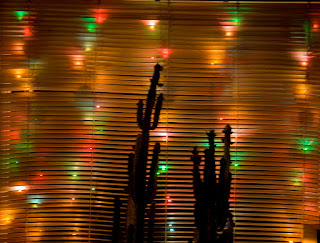At a loss for something to write about today, I asked one of my writing buddies for an idea. She participated in the Christmas bird count on Kauai this morning and has birds on the brain, so she suggested . . . birds. Then she mentioned California condors, and I knew just the thing. Here's the first part of a story I wrote back in 2004. The whole thing used to be online, but is no longer. This'll get you going, though.
Close Encounters of an Avian Kind
The last wild condor was taken into captivity in 1987, joining the 26 others still in existence. Since that time, captive breeding efforts have led to a population of 232 individuals, 97 of which, as of May 1, 2004, are flying free over the Grand Canyon, in Ventura County, in Baja California, and on California's central coast.
In February, my friend Joan and I were doing an easy rock climb at Pinnacles National Monument in the Gabilan Mountains, east of Soledad in the Salinas Valley. She was obscured from view as I belayed her across a low rise, when I heard a screech: "A giant bird landed right
here. What do I do? It looks like it wants to peck me!"

It was all I could do to keep from dropping the rope and dashing over, because as soon as I heard the words "giant bird," I knew: Joan was having a close encounter with a California condor
(Gymnogyps californianus). Six young condors had been released at Pinnacles in January, part of the expanding reintroduction program for this highly endangered species; surely, this was one of them. However, I maintained my cool and waited until she anchored herself and set up my belay.
Then I dashed.
Sure enough, she was being inspected by not just one but two of the most hideously handsome birds I'd ever seen. They were mere feet away. On their wings were large black patches with prominent white numbers, patagial (or wing) tags, to which miniature radio transmitters were attached. Our friends were numbers 265 and 266, and they seemed completely unfazed by our presence. Indeed, they—especially 265—seemed fascinated. As were we.

These were adolescents, with naked black heads (adults have orange-pink heads), elegant feathery ruffs around their necks, huge pale blue feet, and watchful brown eyes—not to mention viciously hooked black beaks, perfect for ripping away at carrion. Hunkered there on the rock, they stood almost waist high.
Since they showed no signs of moving, we sidestepped around them. They extended their enormous wings and hopped away a bit, eyeing us watchfully. Whenever we got a ways away, they'd lift into the air and swoop down again onto a nearby rock for another close look.

This went on for a couple of hours as we made our way through the climb. Eventually a third bird (286) joined the party, though he remained aloof. Once Joan and I settled down for lunch, the three of them picked up and soared into the air. A bunch of crows were circling a little higher up. The contrast in size between crows and condors, with their nine-foot-plus wingspan, was breathtaking.
A couple of months after this incident, I went for a hike at Pinnacles. Now on the general-information bulletin board was a prominent warning telling climbers to stay at least 100 feet away from any condor that approached. And this statement was posted on the Friends of Pinnacles website on March 23: "According to recent information coming from the condor project director, climbers should NOT 'haze' (try to scare off) the condors in any way. Climbers are advised: if you are approached, simply ignore the birds until they are done checking you out."

That got me to wondering about "our birds," especially 265, who was so boldly curious. Was he in danger of being stripped of his wild status? The National Park Service website gave me a preliminary answer. In early April, the condor log reported, this bird was recaptured because of his close approaches to climbers on at least five occasions, a behavior he had "shown no tendency towards ceasing. . . . The hope is that by holding him for a while, he will be taken out of the social interactions of the other free-ranging birds and lose his high-ranking status in the overall condor pecking order. When released, he will have to spend more time and work harder to maintain his place in the dominance hierarchy and have less time and/or inclination to approach humans."
The recapture itself should have helped, too. Sheila Foster, outreach coordinator of the Ventana Wilderness Society (VWS), told me: "Hey, it was a human who caught him and stuck him in this big cage." That sort of manhandling might go a long way toward teaching him to avoid people. The nonprofit VWS is coordinating the Pinnacles condor program.
 |
This IS, I believe, 278, at the
Pinnacles holding area |
A second condor, 278, was recaptured at the same time, I learned, but for very different reasons. That bird, one of the first to be released, was not competing well with the others for food and was taking unacceptable chances with predators. He started off by roosting not in a tree but on the ground. In coyote country, that's not a good idea, so he was removed to the nearby flight pen. On this second go-round in captivity, he had regained weight and appeared to be thriving.

It turned out that 278 had three damaged shafts in his tail, limiting his ability to maneuver, according to Kelly Sorenson, executive director of the VWS. A little time will help him recover. The fact that he is consorting now with five young females and a young male, all recently arrived at Pinnacles from San Diego Wild Animal Park and Los Angeles Zoo and scheduled for release in October, may also improve his status in the flock, placing him higher on the pecking order, a potential boon at mealtime. Although no plans are currently in place for re-releasing 265 and 278, Sorensen stressed that "they're intended to be in the wild," and every effort will be made to see that they fly free again.
The other four free-flying birds, happily, are feeding well, roaming widely, and not approaching people or buildings. One bird, 287—identified from the start as the strongest flyer of the six—is outfitted with a lightweight GPS (global positioning system) transmitter, which allows biologists to track his movements. (The radio transmitters on the other birds are not very reliable in the rugged terrain of the Gabilans.) Since his first short free flight on December 20, 2003, he has expanded his range to encompass almost 300 square miles in and adjacent to Pinnacles.
* * * * *
The piece continues, but as I say, it's no longer online. But I can provide a bit of an update:
Condors 266 and 287 were transferred to Arizona and released at Vermillion Cliffs; 286 was transferred to Big Sur. Condor 265 was returned to Los Angeles Zoo for socialization training, and although he was scheduled to be re-released at Pinnacles,
it appears he eventually joined his buddies 266 and 287 in Arizona. Alas, I find no further mention of 278. I hope he's out there and holding his own.
Currently, Pinnacles manages 32 free-flying condors. They are profiled
here. The numbers start at 310, so the birds I encountered are long gone. But it's good to know the program is doing well. I haven't been out to Pinnacles recently, and the last time I was there, all I saw was turkey vultures (which some hapless hikers thought were condors . . .). But I know they're there, and that makes me glad.
All told, as of 2014 there were 421 California condors—a nice bump up from just 27 in 1987, or 232 ten years ago. Of those, 228 were flying free in the wild (some 120 in California, over 70 in Arizona and Utah, and 30 in Baja), and 193 remained in captivity—many of them breeding and teaching the youngsters how to survive in a wild they'll never know.

 I've already written down a few possible themes, including creativity, stretching, and rootedness. Tomorrow, I'll try to muse a bit more on the idea and maybe narrow down to one idea that I'd like to keep in mind this next year. Pay attention has been a (constant) past theme: perhaps I'll just pick that one up again. It's not a bad one.
I've already written down a few possible themes, including creativity, stretching, and rootedness. Tomorrow, I'll try to muse a bit more on the idea and maybe narrow down to one idea that I'd like to keep in mind this next year. Pay attention has been a (constant) past theme: perhaps I'll just pick that one up again. It's not a bad one.I hope that in this year to come, you make mistakes.
















































